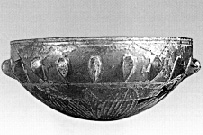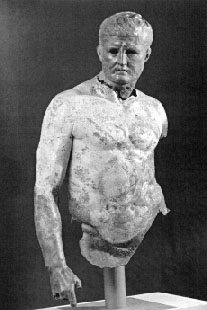|
|
Through all these documents given by the terrestrial and underwater finds, we wanted to make a search on the specific topic of the sea. |
|
Glass cup belonging to the alexandrine production and coming from Canosa’s jewels tomb.
|
|
|
 The sea is the main character of this exhibition, with its courses, the commerce, the landings: mythical landings such as that of Cretans in the Salento’s area; military and commercial landings such as those of Bari, Taranto, Brindisi and Otranto; safe landings such as that of Santa Sabina, an outlet to the sea of a messapian huge inhabited place related to the ancient Carbina (Carovigno), or that of Brindisi which made coin the proverb - ---in the world there are three ports, that of June, July and Brindisi…,- meaning that in the port of Brindisi ships were safe just like when they are sailing the sea in the months of June and July. The sea is the main character of this exhibition, with its courses, the commerce, the landings: mythical landings such as that of Cretans in the Salento’s area; military and commercial landings such as those of Bari, Taranto, Brindisi and Otranto; safe landings such as that of Santa Sabina, an outlet to the sea of a messapian huge inhabited place related to the ancient Carbina (Carovigno), or that of Brindisi which made coin the proverb - ---in the world there are three ports, that of June, July and Brindisi…,- meaning that in the port of Brindisi ships were safe just like when they are sailing the sea in the months of June and July.
But the sea also means fears, shipwrecks, wreckage rich in history and art, and everyday life which smells of wine, oil and fish sauce, transported into amphorae; an everyday life that reflects, in the table pottery, the decorative taste of cultural models of people living in the Mediterranean basin. |
|
Bronze statue of Lucio Emilio Paolo reconstructed from the fragments found in the sea close to Punta del Serrone (Br), half of the IInd century B.C.
Brindisi (Provincial Arch. Museum)
|
|
 The exhibition "Sailing the sea. Apulia and the Mediterra- The exhibition "Sailing the sea. Apulia and the Mediterra-
nean between myth and history" was born from a scientifical project drawn up in 1997 during the XIIth edition of the Mediterranean Games.
This is why we decided to locate the exhibition in the F.Ribezzo’s Museum rooms, as the right continuity with the engagement lavished by the Museum didactic section towards exhibitions, publishings and excavations, in particular in the underwater archaeological sector which awakened so great an interest in Brindisi’s inhabitants when, in 1992, it gave back important bronze sculptures coming from Punta Serrone.
Some of these sculptures, nowadays available thanks to proper restoration operations and exhibited, together with other archaeological finds coming from apulian museums, represent a significant moment of Apulia’s history connected to the sea. |

|